
JAMES R. ARNOLD
TET OFFENSIVE 1968. TURNING POINT IN VIETNAM
Both the Viet Cong and the North Vietnamese lacked the heavy weapons of their opponents.
They essentially operated as light infantry. Since they could not compete with American firepower, they developed a variety of compensatory tactics. Analysis of the initial encounters with the Americans led to the following conclusion according to a Viet Cong general: 'The way to fight the American was to grab him by his belt, to get so close that his artillery and air power was useless.' The Communists had rediscovered the 'hugging' tactics used by the Germans during the Second World War.
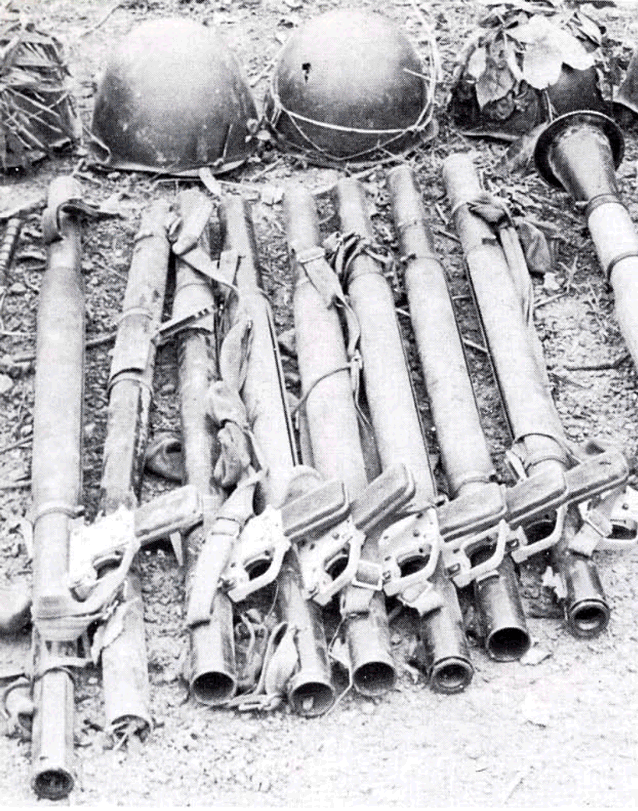
Russian-manufactured rocket-propelled grenades (RPGs) were the descendants of the very successful Second World War German hand-held antitank weapons. Nominally effective up to 500 yards, in combat the NVA and VC employed RPGs at much closer range. RPGs could penetrate up to 250mm-thick armour, easily an overmatch for the M-113's 35mm-thick plating. RPGs and rockets took a terrible toll of Marine Corps tank troops during the street lighting in Hue.
Secondly, the Communists had to counter American mobility. A North Vietnamese general explains how this was done:
'Our mobility was only our feet, so we had to lure your troops into areas where helicopters and artillery would be of little use. And we tried to turn those advantages against you, to make you so dependent on them that you would never develop the ability to meet us on our terms - on foot, lightly armed, in the jungle.'
Often such jungle combats featured the VC/NVA fighting from entrenched positions. If they chose to fight outside fortified areas, the Communists tried to strike hard and fast and then withdraw before American firepower intervened. Usually they sought to engage American units who were moving and were thus more vulnerable. Despite all these tactics, if it came down to a slugging match, the VC/NVA could not compete with American firepower. One NVA combat veteran estimated that 70 to 80 per cent of all NVA losses came from artillery and airstrikes.
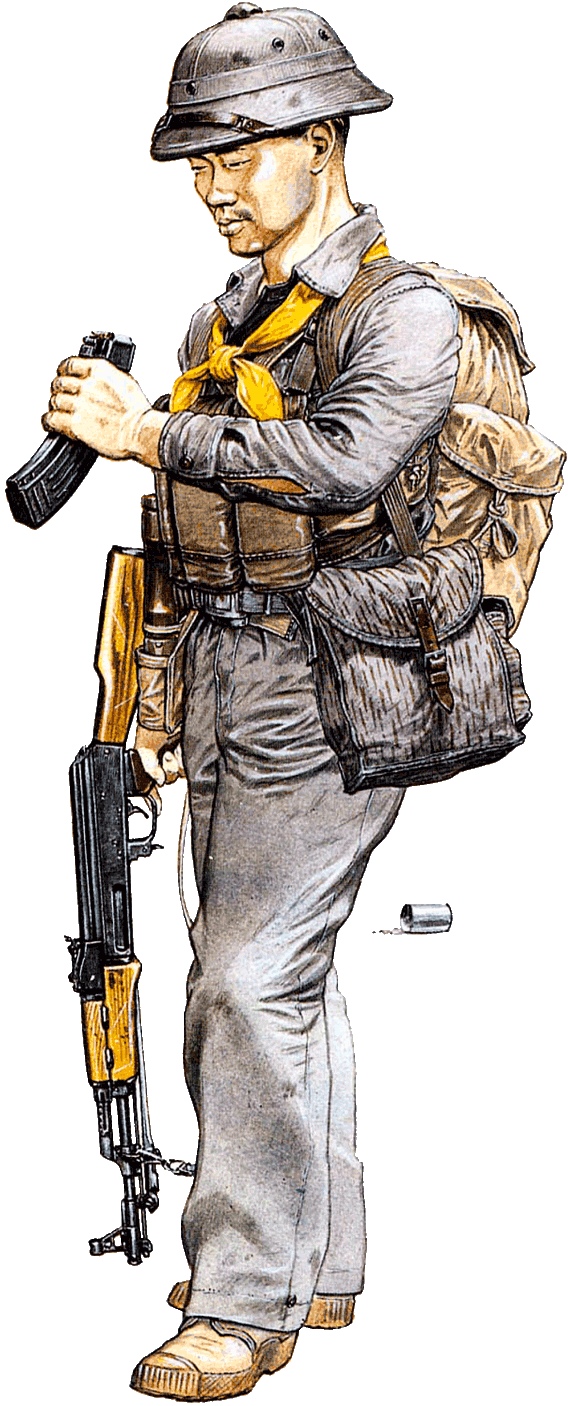
Regular soldier of the NVA. Illustration by Mike Chappell.
The NVA/VC always prepared meticulously before launching an assault. Operations typically began with a careful reconnaissance of the objective. The recon unit, comprising the best soldiers, moved close to the Allied position and then dispatched two- or three-man teams to move in as close as possible to scout the objective. The recon unit paid particular attention to the positions of the defenders' heavy weapons. Upon its return to base, the recon unit diagrammed the objective for the sappers who were to spearhead the assault. The sappers were the second most elite soldiers in NVA units. Frequently, assault troops constructed a sand table of the hostile position. Each unit studied the table and then rehearsed its role. In preparation for infiltrating Allied positions, everyone received instruction in disarming mines and trip flares. In actual assaults, elite sapper units led the way. Even the most formidable-seeming positions proved porous against the Communists' skilled infiltration abilities.
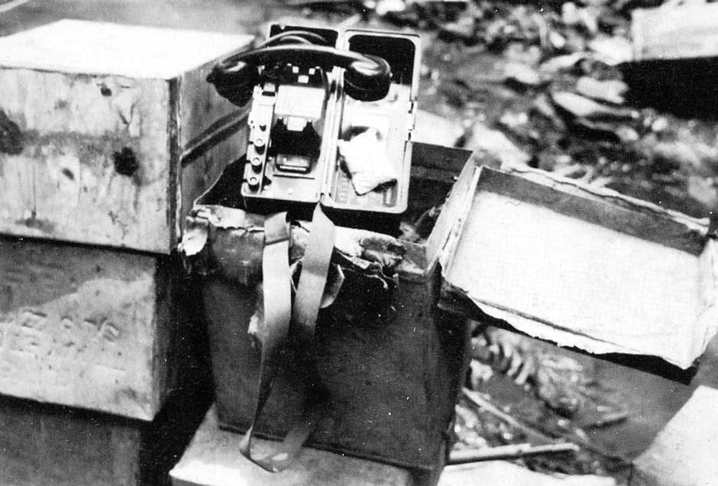
Poor communications forced the Communist attackers to adhere to plans. Such inflexibility caused heavy losses when rapid American counter-measures placed reserves between the attackers and their objectives. In Saigon, in particular, initial Communist successes degenerated into uncoordinated small unit actions. Only at higher command levels did the Communists have field telephones (shown here) and radios.
For the Tet Offensive, most objectives were in urban areas. A prisoner explained the scouting procedures used here:
'In our reconnaissance of cities, we arc normally met by local force liaison people at a prearranged location within or close to the city. The liaison people escort us to the exact positions or locations to be attacked. If there are several ARVN soldiers in the area, we usually disguise ourselves as ARVNs. But in cities where there are only a few ARVN soldiers, we wear civilian clothes.'
The Communists took advantage of the Christmas truce for a final reconnaissance. The commander of the 9th Viet Cong Division, for example, personally inspected his unit's primary objective, Tan Son Nhut Air Base outside Saigon, while one of his regimental commanders visited 'the family grave site' at a military cemetery just outside the base.

A captured 82mm mortar on right stands next to a US 81mm version. The Communists could lire American ammunition even though the tube was slightly larger. Mortar and rocket bombardment heralded most of the initial Tet attacks.
Because the VC/NVA units lacked modern communications, officers could not adjust plans to changing circumstances. Thus assault units received rigid orders to follow the attack plan. A prisoner recounts:
'All units must go by this plan and a soldier must execute an order even if many get killed. They must launch the attack at all costs. The plan always shows how to get into the objective area, where key points to be destroyed are located and how best to exfiltrate.'
In another tactical departure, many attacking units at Tet had no prepared withdrawal routes.
It was a point of discipline and pride always to try to carry away the wounded and the dead. This practice led to the frustrating experience of an Allied unit fighting an intense combat, taking losses, and after the battle finding little to indicate if the enemy, in turn, had suffered.
In the absence of artillery, heavy fire support had to come from rockets, recoilless rifles and mortars. Mortars included 82mm and 120mm weapons. The latter type was a most formidable weapon. Based on Soviet design, the 120mm mortar had a range in excess of four miles. A five-man crew served the weapon and could break it down into three loads to carry it through even the most rugged terrain.
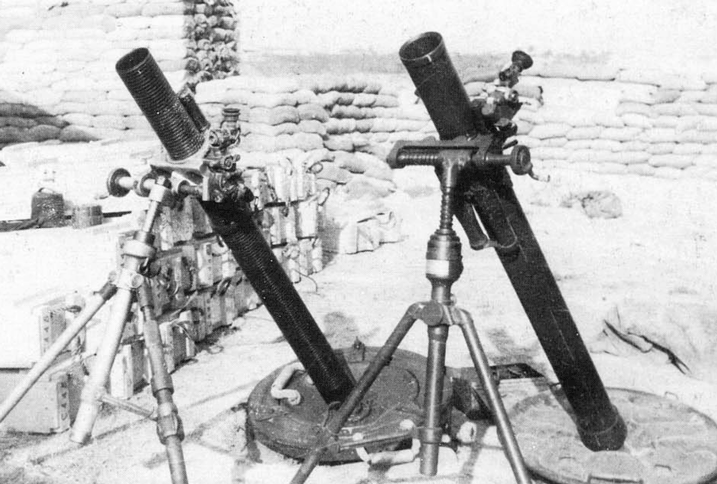
The lightly armed Viet Cong had to find alternatives to compensate for their lack of firepower. They relied heavily upon mines and booby traps. A VC document analysing American tactics stated: 'US troops clumsy and vulnerable to booby trapping and mining.' Mines inflicted about half the damage and destruction American armour suffered. Mines and booby traps caused 10 per cent of US fatalities and 15 percent of wounds between 1965 and 1970. Furthermore, their presence served as a substantial tactical brake on ground operations. When a trap exploded to kill or maim, the infuriating knowledge that local civilians knew the location of nearby booby traps sometimes drove the survivors to commit savage atrocities.
The mortar attack had been a staple of Viet Cong tactics since the war began. Relying upon careful reconnaissance, a mission made easier by the near total lack of concealment of important posts within an Allied installation, the mortar crews prepared concealed firing sites and calculated firing angles before the bombardment began.
Thus they were able accurately to 'walk' their rounds across a base's important installations in a short, intense bombardment. This bombardment both inflicted losses and forced the defenders to keep their heads down. While the defenders were hunkered down, elite sappers spearheaded the effort to breach the defences.
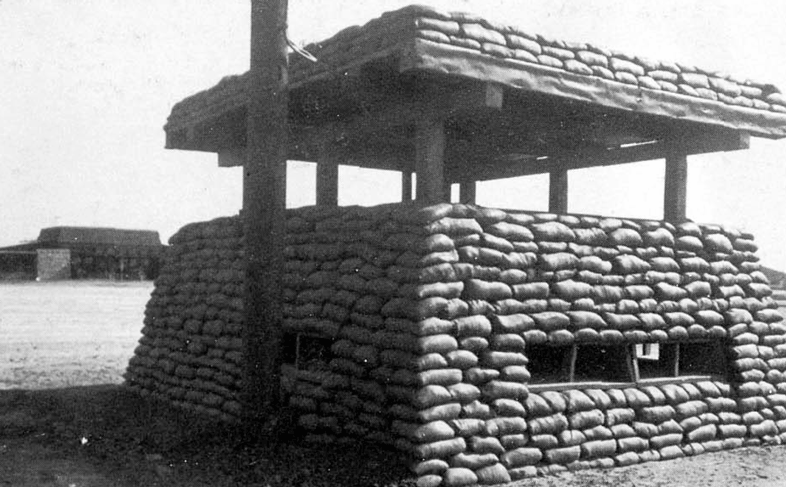
Two approaches to fortifications: an American-built firing bunker defends the vital Long Binh base area, an important target for the Tet Offensive. Such positions were easily plotted by VC recon detachments.
Far less accurate were the free-flight 107mm, 122min and 140mm rockets. Rockets had figured prominently in Russian Second World War tactics, so it is not surprising that the Russians supplied rockets to their allies. The rocket's great merit was that it efficiently delivered a large explosive charge to the target. A 90-pound rocket, transported in two sections, could be carried to its launching site and propel a 35-pound charge to a target 10 kilometres distant. It required a conventional howitzer weighing some 3,300 pounds to equal this firepower. Thus the rocket had a much superior warhead-to-weight ratio. On the down side, rockets were inaccurate. They were useless for hitting discrete targets. Accordingly, Communist gunners employed rockets as area bombardment weapons, particularly against airfields and ammunition dumps, and to deliver sudden, stunning saturation fire to cover an assault. Nationwide, the typical first warning that the Tet Offensive was underway came when mortar rounds and rockets exploded on defensive positions.

In contrast, a VC bunker built to withstand direct hits from artillery and bombs is extremely well camouflaged.
Only along the DMZ did the North Vietnamese Army employ tube artillery. In late 1967 it hauled Russian-designed 130mm field guns into fortified firing positions and began the long-range bombardment of Marine positions. To American generals, this was reminiscent of Dien Bien Phu, and was one more factor drawing their attention north as the Communists prepared for the real assault elsewhere.
In spite of this calculus, the Communist high command's plan called for its soldiers to switch their tactics completely. For the first time in the war, they were to capture and hold selected objectives throughout the country. To do this they had to mass - and this would provide unmistakable targets for US firepower.
When it was all over, it seemed that American intelligence officers had had the pieces of the puzzle in their hands but had been unable to assemble a clear picture of enemy intent. As early as 29 October 1967, the Viet Cong 273rd Regiment had attacked a small district capital and, contrary to normal practice, tried to hold it. They suffered terribly when the inevitable massive Allied air and artillery bombardment drove them out. Intelligence officers could not understand why the enemy risked certain heavy losses for a meaningless objective. With hindsight they understood that the Communists were practising urban assault tactics.
Similarly, in November four NVA regiments fought a bitter 22-day campaign around the obscure border town of Dak To. The Americans redeployed the equivalent of a division to defeat the assault. Captured documents revealed that the attack had been designed to 'force the enemy to deploy as many additional troops to the Western Highlands as possible'. The scheme worked, though again at heavy cost. The American troops had vacated positions around some of the urban objectives specified for the Tet Offensive.
There were other tell-tale signs: a flurry of attacks in Dinh Tuong Province where historically the Viet Cong tested new tactics; a sharp decline in Communist desertion rates (the troops were being told that victory was near); prisoner statements that the entire country would be 'liberated' by Tet. By December 1967, high-ranking American officers had begun to believe that the Communists would try a major offensive in the near future. America's top soldier, General Earle Wheeler, Chairman of the Joint Chiefs of Staff, addressed the US public on 18 December, twenty three years and two days after the surprise German assault in the Ardennes, to say that 'there may be a Communist thrust similar to the desperate effort of the Germans in the Battle of the Bulge'.
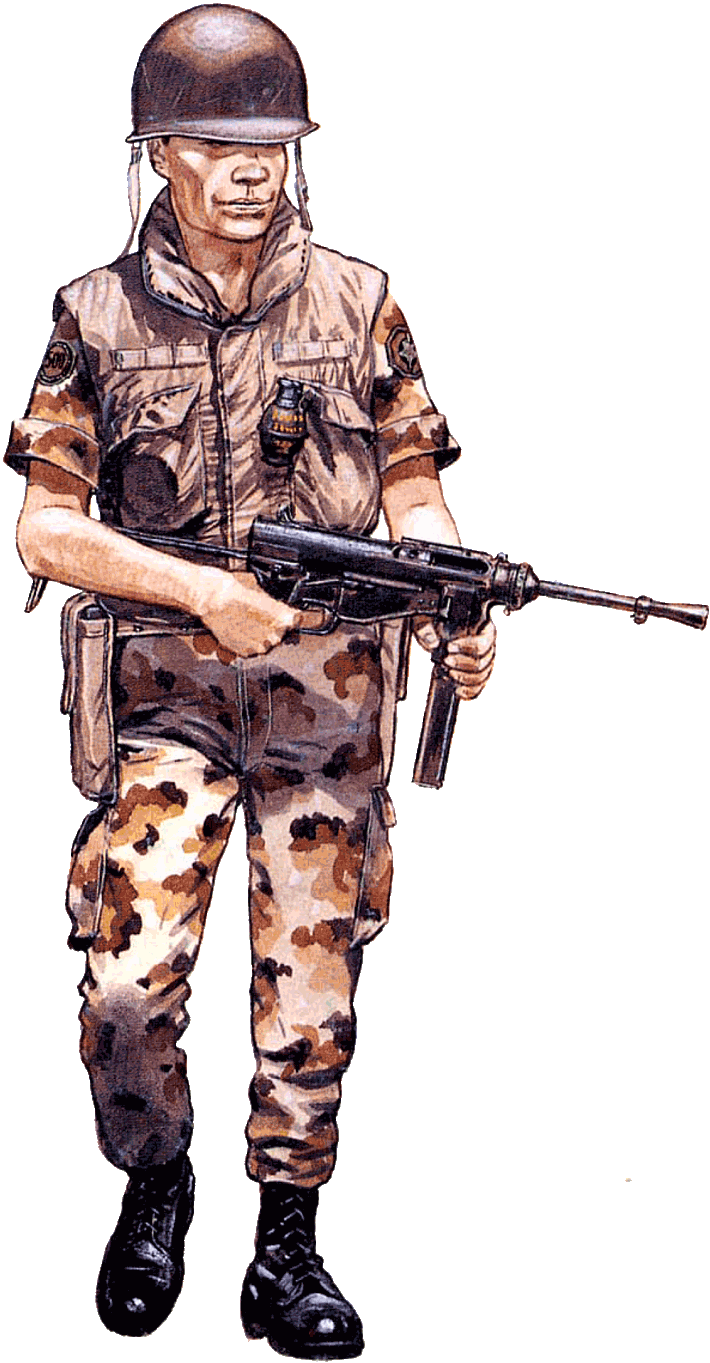
RVN National Police Field Force enlisted man, Saigon. Illustration by Mike Chappell.
Wheeler's warning came from the analysis performed by Westmoreland and his staff, who had been carefully studying captured documents. These clearly described a change in Communist strategy. Accordingly, the general informed Washington that the Communists intended 'to undertake an intensified countrywide effort, perhaps a maximum effort'. The administration responded by speeding up the schedule of troop movements to Vietnam, but that was all. Except for Wheeler's statement, which had little impact, the Johnson administration chose not to reveal Westmoreland's analysis to the public and did nothing to brace the
American people for the coming blow. Having spent the past months claiming great progress, policy makers - military and civilian alike - refused to reverse course. They persisted in painting a rosy picture and by this decision played right into Giap's hands.
On 5 January, the US Mission released documents captured on 19 November 1967, which included an order to the People's Army:
'Use very strong military attacks in co-ordination with the uprisings of the local population to take over towns and cities. Troops should flood the lowlands. They should move toward liberating the capital city [Saigon].'
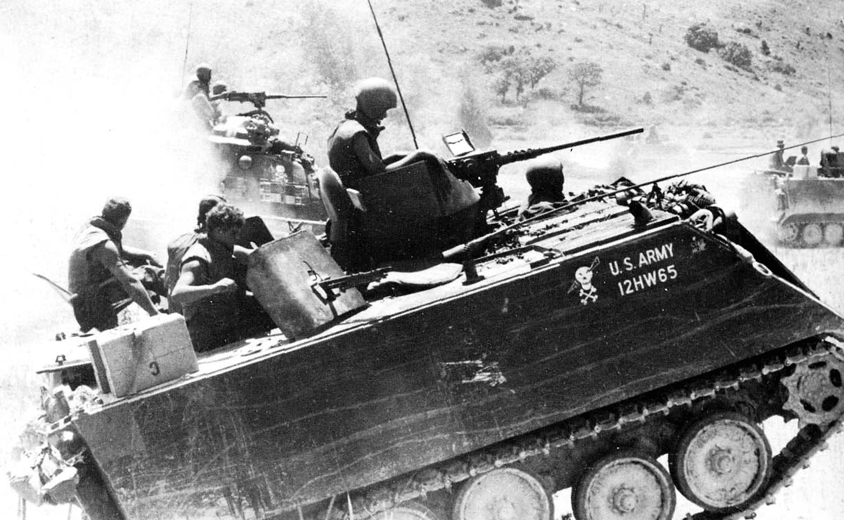
The basic armoured vehicle of the war was the M-113 armoured personnel carrier (APC). Combat experience quickly showed the need to increase the armour and firepower of the APC. 'Technicians bolted extra armour along the sides to protect against RPGs, belly armour to shield against mines and an armoured cupola for the commander's.50cal machine-gun. The addition of two side-mounted M-60 machine-guns converted the vehicle to the Armored Cavalry Assault Vehicle. Mechanized units used the ACAVs as light tanks. They had surprising cross-country ability. The combination of mobility and firepower demonstrated to the high command that armour could usefully contribute to the war. Westmoreland wrote: 'The ability of mechanized cavalry to operate effectively in the Vietnamese countryside convinced me that I was mistaken in a belief that modern armor had only a limited role in the fighting in Vietnam.'
Yet the attached analysis provided by the mission, apparently reflecting the prevailing belief in Westmoreland's headquarters, was that these orders were 'ambiguous' as to the time fixed for the attack and possibly represented 'internal propaganda' designed to inspire the enemy's troops.
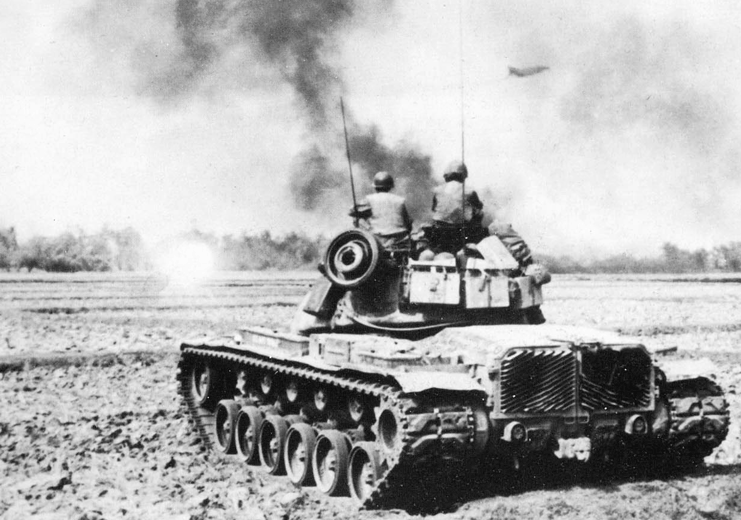
By the beginning of 1968, the Allies had assembled a considerable armoured force. The US Army's contingent included the famous 11th Armored Cavalry Regiment, seven divisional cavalry squadrons, seven mechanized battalions, two tank battalions and an independent tank company, and five cavalry troops supporting light infantry and airborne units. The Marine Corps also had considerable armoured assets. The crack 1st Australian Task Force provided an APC troop. Ten South Vietnamese armoured cavalry squadrons were available.
When the South Vietnamese General Staff later studied the Tet Offensive they hit upon the essential basis for the intelligence failure. Having been taught American doctrine, they were primarily concerned with the Communist 'capabilities and not his intentions'. Capabilities could be quantified, and it was clear to all the Allies that the enemy could not hope to capture and hold urban objectives. Therefore, intelligence officers dismissed all indications that the enemy intended to try anyway.
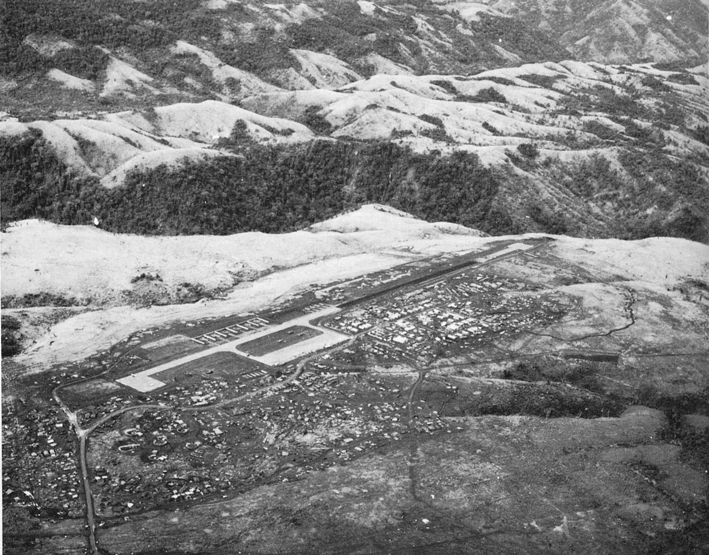
An aerial view of Khe Sanh. Communist pressure against this base caused Westmoreland to divert increasing strength to the northern I Corps region. With hindsight, it appears he was duped by a skilful Communist diversionary build-up.
A second major factor beyond the inability of military intelligence to assess accurately the signs of enemy build-up accounts for the Tet Offensive's surprise. When the American high command examined their strategic maps at the beginning of 1968, they focused on the northernmost provinces bordering the so-called demilitarized zone (DMZ) that separated North and South Vietnam. Since mid-1967, Westmoreland had been shuffling strength northward in response to the enemy's growing strength. By the New Year he had positioned a tremendous amount of available military resources there. The positions included a series of fortified, but isolated, Marine Corps posts along the DMZ. The high command, and President Johnson in particular, feared that a major assault across the border and from neighbouring Laos might turn one of these bases into a Dien Bien Phu. Mid-January patrol actions seemed to confirm the high command's worries: two dug-in NVA divisions had surrounded the Marine Corps combat base of Khe Sanh. In sum, by January 1968, enemy pressure had over-stretched American resources. Distracted by the threat in the north, the US high command seriously underestimated the enemy's potential for major, nationwide attacks.
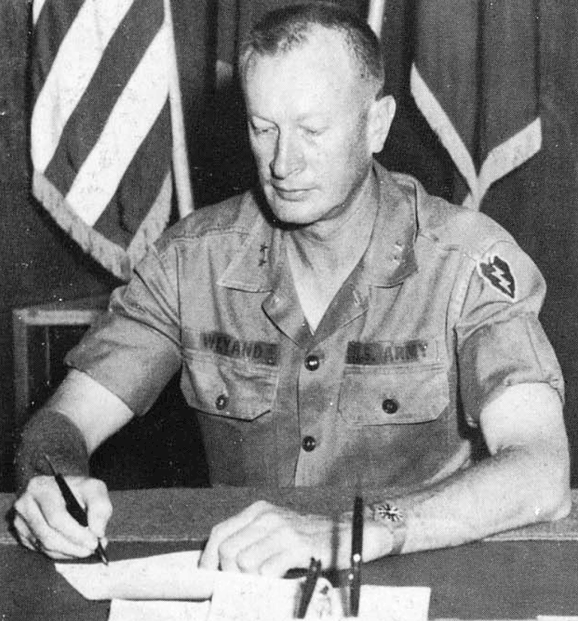
General Fred Weyand sensed too many troops were deployed along the Cambodian border. He urged Westmoreland to recall them to positions closer to Saigon. This redeployment proved to be Westmoreland's best decision before Tet.
Major General Charles Stone (back row, third from right) carefully prepared defensive plans in ease the Communists struck. His care paid great dividends in the defence of Pleiku.
Major General Frederick C. Weyand commanded the American field forces in III Corps Tactical Zone. His command stretched from Saigon out to the Cambodian border. According to Westmoreland's recent strategy, 39 of his 53 manoeuvre battalions were operating against enemy bases along the Cambodian border. Unbeknown to Weyand, as the Americans shifted out from the urban area, the Communists marched in. However, radio intercepts and the lack of contact with the enemy in the border area alarmed Weyand. On 9 January he telephoned Westmoreland to explain his concern and to recommend that forces return from the border. In a key decision, Westmoreland agreed. When the Communists struck, the number of American battalions within the urban zone had doubled. Their presence made a tremendous difference.
Elsewhere, as January progressed, disquieting signs of enemy build-up continued and they too prompted countermeasures. Early in the month, the 4th Division in the Central Highlands captured a plan for an attack on Pleiku. In mid-January, 101st Airborne captured plans for an attack on the province capital of Phu Cuong.
However, the Communist practice of compartmentalizing planning paid dividends. Since neither of the plans mentioned anything except the immediate activities of the units involved, American intelligence officers failed to foresee that they were part of a nation-wide plan. Consequently, counter- measures were left to local commanders. On 26 January the 4th Division commander, Major General Charles Stone, assembled all area commanders and prepared a coordinated response should an attack take place. His foresight stands in sharp contrast to that of other commanders. He also moved a tank company to Pleiku as a mobile reserve. Similarly, a few days later, Westmoreland ordered the 4th Cavalry Squadron to relocate near Saigon's Tan Son Nhut airbase. He reckoned that 'they would provide a ready mobile reserve with impressive firepower'. Both of these small shifts helped when the attack came.
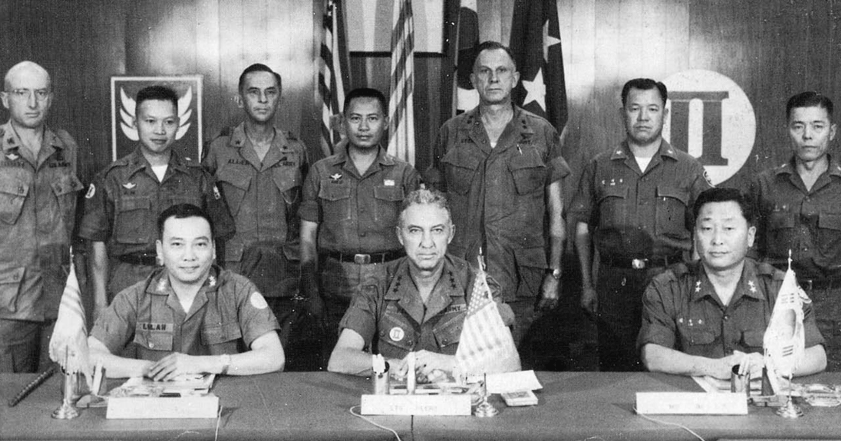
By January, Westmoreland had become sufficiently alarmed to request that the South Vietnamese cancel the coming Tet cease-fire. On 8 January the chief of the South Vietnamese Joint General Staff, General Cao Van Vien, told Westmoreland that he would try to limit the truce to 24 hours. A week later, President Thieu argued that to cancel the 48-hour cease-fire would adversely affect his nation and its soldiers. He agreed to limit the ceasefire to 36 hours, beginning on the evening of 29 January. The South Vietnamese government promised to announce the change one day before it was to take effect. In the event it failed to make the announcement in a timely, useful way. In the IV Corps region south of Saigon, for example, the order cancelling the Tet ceasefire reached headquarters shortly after 10 p.m., a mere four and a half hours before the attacks began.

Downtown Saigon on the eve of the decisive Tet Offensive.
The Americans did little better. During the day of 30 January Westmoreland's headquarters issued a warning directing that 'Troops will be placed on maximum alert with particular attention to the defense of headquarters complexes, logistical installations, airfields, population centers and billets.' This warning covered the prime targets of the impending assault, yet it either came too late or was largely ignored.
So, heedless of coming crisis, the South Vietnamese prepared to celebrate their lunar New Year. The celebration's peak would come on the night of 30 January. The official ARVN history describes the nation's mood:
'A relative lull seemed to be prevailing all over South Vietnam... leaves were readily granted the troops for the lunar New Year and measures were taken by the Administration to give the common people as normal a Tet as possible... The people had forgotten about the dying war. They wanted to celebrate Tet with as much fervor as in the old days.'
During the night of 30 January revellers swarmed the streets of Saigon to greet the New Year of the Monkey. Soldiers belonging to the local garrison had not received word the authorities had cancelled the truce. But everyone knew that the ban on fireworks had been lifted for the holidays, so the explosions of thousands of traditional fire-crackers rocked the air. Slowly, as Viet Cong assault forces moved from their safehouses into attack position - some of the 67,000 committed nationwide in the first wave - the sounds of combat replaced the sounds of festival.
We have much more interesting information on this site.
Click MENU to check it out!
∎ cartalana.com© 2009-2025 ∎ mailto: cartalana@cartalana.com